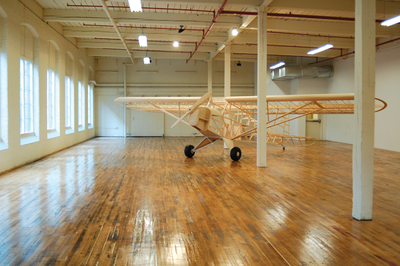Mark Wethli: Piper Cub; Sam Cady: Parts of the Whole

Sam Cady, skylight with blue shadow, 1979, oil on shaped canvas, 22 x 48″.
The painter Sam Cady is renowned for his shaped canvases in which, to borrow from the title of this retrospective, parts of the whole are presented, often with trompe-l’oeil precision. The 34 pieces in this show, produced between 1970 and 2016, offer a wide-ranging selection of Cady’s cut-outs, from a construction trailer on Canal Street in New York City to a section of the Knife Edge trail atop Mount Katahdin in northern Maine.
Born in Boothbay Harbor in 1943 and a longtime resident of Friendship in the midcoast, Cady has taken a special interest in coastal motifs. Islands are among his favorite subjects, especially Sand and Little Sand, which lie between Hatchet Cove and Muscongus Bay. He presents them in profile or from a gull’s-eye angle, their edges cut to incorporate spruce trees and their reflections. The illusion is astonishing.
The show also features a group of Cady’s urban images. As a teacher in the MFA program at the School of Visual Arts in New York City for 25 years, he had the opportunity to study and render the Big Apple in what might be called a synecdochical manner. Two urban towers, midtown Manhattan, 1998, is a dramatic skyward view of shimmering buildings cutting into the sky like a trapezoidal wedge of glass.
Skylight with blue shadow and stairwell roof house, N.Y.C., both from 1979, bring to mind some of Lois Dodd’s city scenes. Like Dodd, Cady is a tonalist when it comes to color, for the most part preferring a quiet palette. Form, space and chiaroscuro guide his aesthetic.
Occasionally Cady will focus on a single object. F Admiration with center button (husband), 1974, a self-standing reproduction of a green upholstered pillow, recalls some of the witty frescos of his contemporary Barbara Sullivan. In several pieces he captures the svelte lines of boats: a dory tipped up on its keel, a single scull that Eakins would have admired for its precision contours.
The exhibition includes a few traditional rectangular paintings, including a New Mexico landscape and a view of a storm at dusk as seen from an airplane window. While appealing, the pieces, through no fault of their own, lack the edgy dynamic of their neighbors. An exception is loading up on the Mississippi at New Orleans, 2015, a small rendering of industrial dock activity worthy of Charles Sheeler.
One of Cady’s earliest pieces in the show, balsa model plane under construction, fuselage, 1974, makes a nice segue to Mark Wethli’s near-concurrent installation, Piper Cub, a full-scale replica of a Piper J-3 aircraft made from pine, birch plywood and aircraft parts. The plane, which was previously displayed at the Coleman Burke Gallery in Brunswick, ME, in 2007, was reassembled for this showing.
Mark Wethli, Piper Cub, 2007, pine, birch
plywood, and aircraft parts, 35 x 22 x 7′. Private collection.
Oldenburgian but without the humor, Piper Cub is a hybrid: an outsize model airplane doubling as a sculpture. The aircraft is mostly seethrough; its warm, yellow wood wings, struts, engine and propeller set on black rubber wheels. The piece has personal significance: Wethli’s pilot father restored a Piper Cub by hand when the artist was a young boy; he also helped his son fabricate the one on view.
Since moving to Rockland in July, the Center for Maine Contemporary Art has returned to offering exhibitions year-round (it had shifted to a seasonal schedule at its former quarters in Rockport in 2009). The new CMCA space provides more room and bigger walls, making it the ideal venue to present the Cady and Wethli works.

